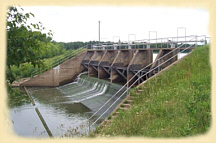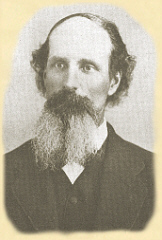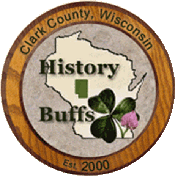|
Mead Lake Dam |
Mead Township Clark County, Wisconsin
Contact us if you would like to become the Webmaster for this township. |
||
|
Cemetery
Schools
Clark County
Community Spirit History Maps
News Organizations
|
Mead Township was formed in in tandem with that of Longwood on Nov. 16th 1895, by order of the county board. Each of them were duly organized at a spring town meeting in 1896. Mead, the 27th of the 33 townships to be formed in Clark County, Wisconsin, was named in honor of William Harrison Mead. It was originally twice the size it is today and spanned townships, towns 28 ranges 3 and four west, but was later subdivided to form Butler from its west half. Mead's first town meeting was held at the home of William Vollrath.
William Harrison Mead, better known throughout the county as "Harry" Mead, was a pioneer settler on the Black River, on section 3 of Warner Township. The first off-spring of Van Renslear and Margaret (Marshall) Mead, He began life in Pauldings, Dutchess Co., New York., Nov. 19, 1833. Harry's grandpa, Moses Mead, fought in the war of 1812. In 1845, at the tender age of 9, his family moved to Watertown, Jefferson Co. Wisconsin. There, he was educated in the public schools and grew to manhood, after which he followed various occupations.
On July 4, 1861, he was united in marriage in Jefferson County, with Julia Arvilla Smith, who was also haled from the Great Empire State. She was born in Fulton County on May 26, 1842 to Christopher and Betsy (Pedricks) Smith. Her widowed mother, two brothers and two sisters had settled in Jefferson County, in 1851.
During the last year of the Civil War, Harry was in the United States service, engaged in putting up telegraph lines in Western Virginia. In 1865, with two small children in tow, Harry and Julia packed a wagon and started westward through a wild country, over the roads that lead to Clark County. It took 2 days to reach Neillsville, where only five houses had been erected. They then entered the densely tangled timberlands to make their way to what is now the location of Greenwood. The first night, they stopped at the home of Case S. Honeywell (who had a mill had a mill on Gile Creek, about 3 miles north of Greenwood). The Honeywell home was the only one for miles around. The next day, Julia & Harry set up housekeeping in what became known as "the old Dwyer house." In the early spring of 1866, they moved to their homestead in Warner and began living in a little log shanty, built without a nail in it. They had 160 acres and the snow was then three feet deep! The home stood in the only clearing, the rest of the farm being heavily covered with pines and hardwoods. During the first seven months, Julia was the only white woman in the woods. Not long after arriving, these sturdy pioneers began feeding travelers, furnishing them with tents to sleep in. Julia continued providing these accommodations for about seven years, while Harry cleared the land and " grubbed the stumps" to transform it into a farm. The hay was cut by hand, raked with a wooden, handmade rake and often carried up for winter use on poles.
Their first supplies were purchased at Black River Falls and generally carried home on Harry's back. They had a dog which Julia chained to the door of the cabin to keep the children safe whenever she need to track down their one cow and calf in the heavy forest which bound them on every side. On arriving at their new home some first slept in booths made of brush until a pole shanty could be made, others in tents. Larry Drinkwine's first home was of logs twelve by twelve feet, and roofed with elm bark, but was large enough for himself, wife and three children. Mr. and Mrs. Harry Mead, who came in 1865, found only one house in the midst of the dense forest. The next spring they moved onto their land into a house which they built without a nail, using wooden pins and hinges, and for seven months Mrs. Mead stated, she saw only one white woman. She also said it took very little to give the settlers a good time. They made much of their own furniture and clothes, exchanged their few books, went to dances long miles afoot or with ox-teams. Mr. Mead would walk over the muddy roads to Neillsville and carry home on his back flour and other groceries; at times the mud was almost knee deep. Mrs. Mead boarded and washed for the men in camps, saved her money and with it bought the Hackett place which for years was known as "Mrs. Mead's dirty shirt farm". Some trappers stopped with the loggers where Harry was working, and caught over $1,000 worth of furs in about two months. A man named David Smith came into their camp in the winter of 1866-67, and in six weeks caught $600 worth of furs. Mr. Mead hunted about five years during the fall of the year, after coming to this county, and killed about forty deer each fall, and also killed a few bear and many wildcats. There were many Chippewa Indians throughout the area, but they were not troublesome. For three years, their nearest neighbors were in Greenwood.
In the early days, Harry and Julia carried the mail on horseback from two miles south of the present location of Greenwood to George Huntzicker's hotel, one mile south of where Longwood now is.
Case S. Honeywell started the first store in Greenwood, but it later burned down. The first real hotel was built and run for several years by W. H. Begley. Julia said, "We used to hitch up our oxen and drive to George and Henry Huntzicker's and dance till broad daylight, to music furnished by one fiddle, played by Tom Syth. My best dress during all those times was taken from the back of sheep by my own hands, while I lived in Jefferson County. The Eatons' and Honeywells' wives and daughters-four women and four girls-were all who attended these dances during the winter of 1866."
Soon after his arrival in Clark County, the growing importance of the timber industry, quickly attracted Harry's attention and led him to change his occupation, as he saw that it was easier at that time to extract wealth from the forests than from the soil. Accordingly he invested in timber lands and for the next twenty years was known as one of the leading loggers and lumbermen of this part of the state, at one time, in partnership with others, owning as much as 10,000 acres of land.
In 1871, they Meads built a new house and resumed farming, clearing and improving about 200 acres. He remained on that farm until about the year 1893. The Meads eventually owned 1,920 acres of their own land, mostly hardwood timber land and had cleared 260 acres of it.
In addition to investing heavily in timber lands and farming pursuits, Harry held various offices in his town and county. He even served on the County Board for many years and even acted as chairman for the board of supervisors for two years. In 1891 he made a close race as a candidate for member of assembly on the Democratic ticket, being defeated by only four votes, by the Republican candidate Hon. Phillip Rossman. William Mead died in 1911. Harry was also member of the Masonic, I. O. O. F. and the A. O. U. W. lodges.
Harry and Julia had seven children, six of whom lived to adulthood: Frank A., Clara, Helen, Harry, Angus and Philo. Clara married Allen Armstrong, of Greenwood and has two children, Glen and Margery. Frank is an express messenger on the O. R. N. Railroad in Oregon.
Sources: Robert McBride's 1909 History of Clark County, 1918 History of Clark County, 1934 Greenwood History; Family Records & Obituaries.
|
|
© Every submission is protected by the Digital Millennium Copyright Act of 1998.
Show your appreciation of this freely provided information by not copying it to any other site without our permission.
Become a Clark County History Buff
|
A site created
and maintained by the Clark County History Buffs
Webmasters: Leon Konieczny, Tanya Paschke, Janet & Stan Schwarze, James W. Sternitzky,
|


